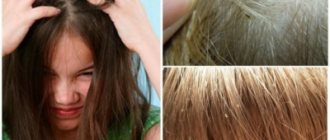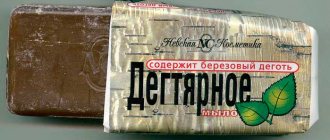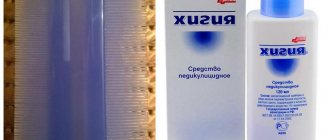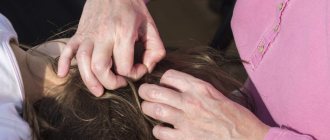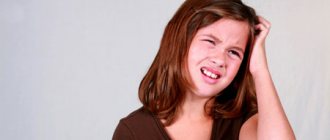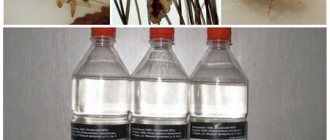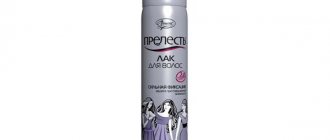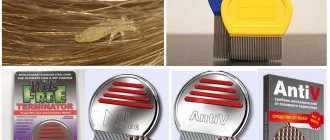How to identify lice in a child
These insects can only crawl fairly quickly; they cannot jump. Therefore, they are transmitted from person to person only through direct contact or through the use of household items on which they were found. The presence of lice can be determined by the following symptoms:
- • severe itching (usually in the temple area, behind the ears, on the back of the head);
- • the appearance of small wounds and bites on the skin;
- • presence of irritation on yellow crusts on the skin;
- • decreased sleep and appetite
Often, infection begins with just a few insects, and after 3-4 weeks their colony grows significantly. Lice and nits themselves can be detected not only on the head, but also on the eyebrows.
From the outside, lice and nits may appear to be dandruff in the hair, but if you take a closer look, the difference becomes noticeable. A thorough visual inspection is needed to confirm an infestation.
Prevention
Preventing lice in children is not as simple as in adults. It can be difficult for parents to explain to their children why they cannot exchange clothes and hats with other children and why they cannot play in unsanitary conditions.
It is necessary to additionally monitor lice prevention in children, check the condition of their hair, and use products, such as special shampoos.
Currently, there are a large number of preventative measures, ranging from folk remedies to special pharmaceutical products. Such products create an environment on the head that is unsuitable for insect life. If lice get into your hair, they will feel uncomfortable there and will leave your head as soon as possible.
Folk remedies
Our grandmothers also knew that in order to avoid getting infected with lice, it is necessary to lubricate the skin behind the ears and temples with the following products:
- Hellebore water. This product must be used as carefully as possible, since hellebore water is poisonous. The advantages of this product are that it quickly destroys lice and also heals the hair. Cons: dangerous if used incorrectly, only affects sexually mature insects, but not nits, cannot be used during pregnancy.
The product can be purchased at any pharmacy. Hellebore water is used only externally. You should not rub it into the scalp for a long time and vigorously, as the side effects of this product can make themselves felt. When using, gloves must be worn to prevent hand irritation. It is necessary to wash off with running water using tar soap. - Essential oils. For example: tea tree oil, lavender, geranium, eucalyptus. The effectiveness of these oils is associated with a pungent odor that lice cannot tolerate. Pros: these products are natural and harmless. Disadvantages: using these means it is impossible to achieve complete destruction of insects. Only lavender oil can be used in its pure form; the rest must be mixed with a base oil (grape, olive, etc.).
Also on our website you can find out in more detail about the following folk remedies for lice: vinegar, kerosene, dichlorvos.
Specialized means
Means for the prevention of pediculosis in children include: special shampoos, anti-pediculosis sprays, hair combs. When using medications, you must strictly follow the instructions.
- Paranit repellent. It is based on anise oil, which can repel lice. The main advantage is the absence of toxins. The only downsides are the smell and price.
- A-par. This product is used to disinfect combs, personal hygiene products, clothing, and bed linen. Pros: avoids re-infection. Cons: cannot be used for bronchial asthma.
- IceGuard. A set of anti-lice combs is used to comb out lice and nits from hair. The advantages of this type of comb: suitable for all hair types, reusable, easy to clean. Cons: repeated processing.
- Rosh Tov. This spray is good because it contains various essential oils and plant extracts. Pros: destruction of lice and nits, relieving inflammation of the skin and eliminating itching. Cons: intolerance to some components.
- Pedilin. Shampoo for prevention against parasites. Pros: practically not dangerous to humans, effectively fights insects. Cons: prolonged contact with skin may cause allergic reactions.
- Paranit. The safest shampoo for the prevention of head lice in children. The advantages are that it does not contain toxins and harmful substances that can harm the child, and it perfectly kills parasites.
How to find lice in a child's hair
You will need to arm yourself with a special comb, which you can buy at the pharmacy. It has very frequent teeth with increased rigidity. Combs with shorter teeth are designed for short hair, and long ones for long curls.
Parting your hair, look carefully at the strands and scalp. If at first glance the hair seems clean and the skin does not cause suspicion, separate a small strand and comb it with a comb, then inspect the rest of the hair one by one. Pay special attention to the areas behind the ears, at the temples and at the back of the head. If the hair is long and thick and is often tied into a ponytail, it is also worth examining the upper third of the hair to about half. After each comb through your hair, wipe it with a clean, light-colored cloth. The nits you remove will be clearly visible against a light background.
The lice themselves range in length from 1 to 5 mm and are shaped like a sesame seed. Their color ranges from beige to brown, and nits are usually dirty beige or grayish. They are attached at the very base of the hair, closer to the scalp, where the temperature is higher.
Memo: eliminating lice at home
If you find out that there is an outbreak of disease in an educational institution, you need to take measures:
- 1. Regularly inspect the hair of household members with a fine-toothed comb. It is most convenient to comb the strands over a table with a light cloth laid out, on which the combed parasites will be clearly visible.
- 2. If lice are found on a child, you need to use a remedy for lice. Focus on safety and effectiveness. Many first-generation products no longer show the desired result due to the established resistance of parasites to them. New generation products “PARANIT” act on a different level, blocking insects’ access to oxygen. Moreover, “PARANIT” is safe for health, and “PARANIT Sensitive” is even approved for use in children over 1 year old, pregnant and lactating women.
- 3. Wash bed linen and wearable items at a temperature of 90 C. Soft toys and other furnishings that cannot be washed and ironed, wrap in bags and put in the freezer or on a cold balcony for 2 weeks.
- 4. After treatment, after 7 days, you need to carefully check your hair again, and repeat the treatment if necessary. PARANIT products retain their effectiveness even with repeated application.
- 5. You need to check the hair of all household members during the entire period of treatment for head lice.
- 6. Use a repellent that will help avoid primary or re-infection in a group. "PARANIT Repellent Protection against lice" is odorless, hypoallergenic and suitable for children.
Pediculosis is not scary if you are armed with the necessary knowledge and an effective cure for it!
Prevention of head lice in children
As a rule, already pronounced symptoms become noticeable. The child often scratches his head, is worried and irritated; lice and nits on the hair can be noticed at the first inspection in a well-lit room. However, in order to prevent active reproduction of parasites and prevent infection, it is important to take preventive measures.
Talk to your child on the topic “How to understand that you have lice”, tell us more about these insects, and about when you need to turn to your parents for help. If your son or daughter is too young to explain this to them, examine them yourself during bathing and hygiene procedures.
It is also important to ensure that the child has his own comb, towel and other hygiene items. It is recommended to put the comb in its case. It is recommended to remove hats and scarves in public institutions to avoid contact. You must wear a swimming cap in the pool.
Simple rules of personal hygiene will help prevent the appearance of lice and teach your child to be careful. If you are faced with head lice, getting rid of it will not be difficult. It is important to inform your child’s caregiver or teacher about it, as other parents should also take preventive measures. Pediculosis is not a disease, it does not require quarantine or special measures, all that is required is the awareness of parents and timely treatment of both children and their environment.
How to protect your child from lice at school?
No matter how tidy your child is, he is at risk of getting lice. Especially if you are in junior or middle school. The fact is that in the summer many schoolchildren relax in children's camps and dachas, from where they often return with such a nuisance as lice. And if parents do not notice this in time and do nothing, children carry a blood-sucking army of parasites on their heads to school and infect their classmates with them. The appearance of lice often causes panic among parents. But let's put aside the panic! Let's learn to take action in advance!
What you need to know about head lice?
Head lice infestation (doctors call it “head lice”) has nothing to do with personal hygiene. Even the most inveterate cleaner can develop blood-sucking parasites that cause a lot of trouble.
99% of infections occur through direct contact “head to head”, so the main risk group are children who, at their age, are very close contacts, especially during joint games.
Once on the head, lice begin large-scale work: they not only bite, but also actively reproduce. Lice eggs (nits) are attached to the hair with a special sticky secretion and wait to mature. In a word, even if you catch a spotted louse and deal with it, this does not mean that after a few days its offspring will not continue the “lousy” business.
Prevention of pediculosis: how to prevent infection?
In order to avoid infection with head lice, it is important to follow simple rules of prevention:
- during outbreaks of head lice (period of increased danger - summer and the first 2-3 weeks after the holidays), regularly examine the child’s head;
- If your child is infested with head lice, notify the class teacher and the parents of the children with whom your child most often interacts. The main thing is to examine all children as quickly as possible and get rid of lice if they are found. Thus, the chain of transmission of lice from child to child in a children's group is broken.;
- Make sure that your child always has a neat hairstyle: boys are recommended to wear short haircuts, girls should wear long hair in braids;
- Use products to prevent head lice at home.
How to choose a product for the prevention of pediculosis?
Today, the choice of means to prevent head lice infection is, alas, small. Among the repellents is one developed using special technology, providing protection for up to 24 hours.
The repellent contains a special ingredient IR3535, which repels adult parasites and prevents them from laying new eggs. The drug is recommended for use during “dangerous” periods - in the summer and in the first weeks of school after the holidays. Paranit Repellent is suitable for daily use by adults and children over 3 years old.
Who needs to use Paranit Repellent “Protection against Lice”?
A remedy for the prevention of head lice will help:
- For elementary and middle school students at the beginning of the school year: the repellent will help prevent them from catching lice from classmates returning from vacation;
- For children treated for head lice: using repellent will help avoid re-infection in the school environment;
- For parents of a child who has lice: the repellent will prevent the spread of lice within the family while the child is undergoing treatment.
How to apply repellent correctly?
For Paranit Repellent “Protection against Lice” to work effectively, follow the instructions for use:
- apply the repellent to clean, dry hair, after combing it or styling it;
- spray the product onto the entire surface of the hair from a distance of about 20 cm, paying special attention to the back of the head and the area behind the ears;
- depending on the thickness and length of the hair, apply 20-25 sprays;
- After application, do not use a hairdryer - let your hair dry naturally. The product dries on the hair quite quickly;
- Treat your hair with Paranit repellent daily and after each hair wash during outbreaks of head lice, as well as after treatment with lice products to avoid re-infection.
Protect yourself and your loved ones from lice!
Find out more at https://vsham.net/
Certificates of state registration:
PARANIT Repellent “Protection against lice” - SoGR No. RU.77.99.88.002.E.006585.08.14 dated 08.08.2014
As an advertisement
Before use, read the instructions or get advice from a specialist by calling 8-800-250-17-35.
published 30/08/2016 08:58 updated 30/08/2016
What is pediculosis and how to recognize it in time
Pediculosis is a disease associated with the appearance of lice and their eggs (nits) on human skin and hair. Small insects parasitize humans, feeding on their blood. Depending on the habitat of lice on the body, pediculosis is distinguished:
- head - parasites infect the scalp;
- clothes - insects choose to place folds of clothing;
- pubic - lice settle in intimate areas.
In children, the first option is most common, and the second option is slightly less common.
Danger of the disease and incubation period
Pediculosis is contagious and dangerous due to its rapid spread. Children and primary schoolchildren do not have very strong immunity, and therefore it only takes one infected person for the disease to spread to the entire team. Each child, in turn, can transmit the disease to adults - mom and dad. And if there are additional family members living together, then the distribution area of parasites increases many times over.
Lice in hair multiply very quickly
By contacting human blood, lice can infect children with dangerous infectious diseases, as they are their carriers. Also, scratching itchy wounds from insect bites can lead to dermatitis, allergies, eczema or purulent inflammation. And if you don’t start eliminating parasites in time, the disease can cause a staphylococcal eye infection, which is very difficult to treat. Due to frequent bites, the scalp becomes rougher, and an inflammatory process may begin, leading to pigmentation (melanosis). Tangles appear in the hair, which prevent the wounds from healing.
As such, there is no incubation period for pediculosis. Insects, as soon as they land on a person, begin to bite in a matter of hours, since they cannot do without food. However, a person may not notice the activity of a pair of individuals. You can really feel the appearance of lice after three to four weeks, when the larvae have time to develop. In winter, the ripening period can be reduced to 16 days. This is explained by comfortable temperature conditions in the room for parasites, as well as the presence of hats on their heads.
Therefore, the process of ridding children of lice and nits must begin as early as possible - when the first signs of infection appear.
Where do lice come from in children - favorable factors
Infection with pediculosis most often occurs in places where children gather - kindergartens, schools, camps, clubs, and dormitories. The main factors contributing to the appearance of parasites are:
- contact games of children - with close contact, insects crawl from an infected head to a healthy one;
- personal hygiene items - use of one comb, hairpin, headband;
- items of clothing - most often those that are closer to the head (hats, scarves, caps, hoods);
- bed linen - lice remain there after the infestation and can move to another sleeping person;
- swimming in the same water as the patient (for example, a swimming pool or natural pond);
- nervous stress and anxiety - oddly enough, it is in this case that parasites show the greatest interest. This is due to the fact that nervous tension causes the blood to pulsate stronger and the sweat glands to work more actively, which attracts bloodsuckers.
Symptoms of infection
The main signs of lice in a child are constant itching, skin irritation, and pustular inflammation.
Secondary symptoms may include nervousness, decreased appetite, loss of concentration, and increased hair loss.
If an infection occurs in the scratched areas, a slight increase in temperature to 37.5°C and swelling in the area of the lymph nodes may be observed.
When the first suspicion of pediculosis appears, it is necessary to conduct a thorough examination of the scalp to detect lice and nits.
Causes of lice
The cause of lice in children is lice that live on the human body in the hairline.
The source of infection is the patient; transmission of parasites occurs through close contact. In this regard, children attending kindergartens, schools, and clubs are at risk for head lice. Girls with long hair are especially susceptible. Infection is also possible through the use of hygiene products that belong to the patient. This is how lice get onto a child’s skin in a hairdresser’s salon (if the workers do not properly handle the tools). There is a risk of infection in transport, bathhouses, and swimming pools.
Doctors also identify factors that increase the likelihood of developing head lice:
- weakened immune system;
- unfavorable living conditions;
- failure to comply with hygiene rules.
Most people believe that lice are a sign of a dysfunctional family in which a child lives. But that's not true. Children living in normal conditions can also become infected. It is important what environment the baby is in and what his state of health is.
How to avoid infection - preventive measures
To minimize the likelihood of lice infection, the following preventive measures must be observed:
- maintain personal hygiene - wash the child several times a week, comb hair, regularly change underwear and bed linen;
- hold a conversation with children so that they do not use other people’s household items and do not give them their own - combs, hairpins, hats, etc.;
- avoid contact with infected people;
- conduct periodic hair inspections, especially after the child returns from a children's health camp or in the fall before the start of the school year;
- add essential oils to your daily hair wash;
- It is better for boys to have short haircuts, for girls to collect, pin up or braid their hair;
- After treatment, it is better not to use the child’s clothing, which could be susceptible to infection, for two weeks (even after appropriate treatment), during which time all surviving individuals will have time to die without food.
What to do if lice are found at school or kindergarten
Pediculosis in a school or kindergarten rarely becomes the reason for official quarantine and closure of the institution. In this regard, when a person with lice appears in the group where your child is located, you need to take care of protecting your own child yourself.
First of all, it is necessary to conduct a thorough examination of the hair, as well as wash and steam the child’s clothes, bed linen, and disinfect personal belongings.
If your child has long hair, teach him to wear his hair up. Try to explain that you cannot exchange your personal belongings (hairpins, combs, hats) with friends.
You can apply a little essential oil mixed with sunflower to the area behind the ears. Carefully! Essential oil can cause allergies; if signs appear, be sure to stop using it.
Treatment of pediculosis
To treat head lice in children, special shampoos and medications are used. The hair is treated with medications, and then the dead lice and nits are combed out. For children, drugs in the following forms are suitable:
- soap;
- cream;
- shampoo;
- spray;
- cleaning liquid;
- lotion.
Antiparasitic agents attack the nervous system of insects and paralyze them, after which the adults die and are easily combed out.
However, nits turn out to be resistant to these agents, so after 1-2 weeks the treatment must be repeated. The traditional treatment regimen involves applying the medication to the hair. Then the head is wrapped in polyethylene and a towel and left for 1-2 hours (be sure to read the instructions). The product is washed off with regular shampoo, then the paralyzed lice are combed out from damp hair.
Not all medications are suitable for children. Therefore, how to treat pediculosis in children, check with a specialist. Products containing permethrin and phenothrin should be avoided in children under 3 years of age with sensitive skin. Medicines containing malathion are quite toxic, so they are not suitable for skin allergies when the permeability of the dermis is increased. A dermatologist will help you choose the right drug.
